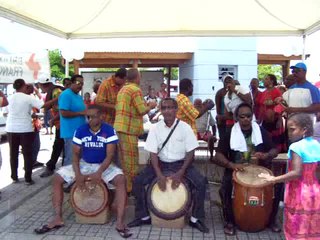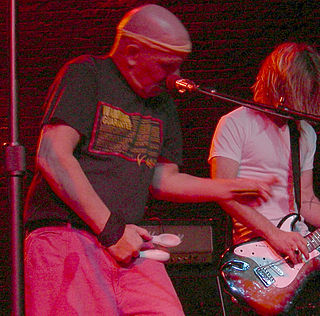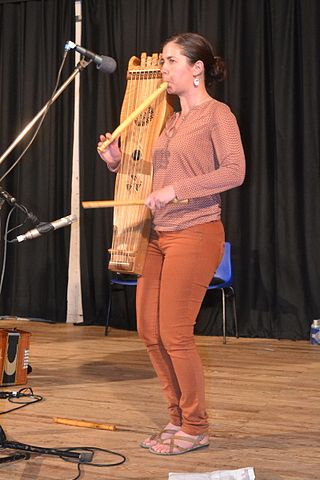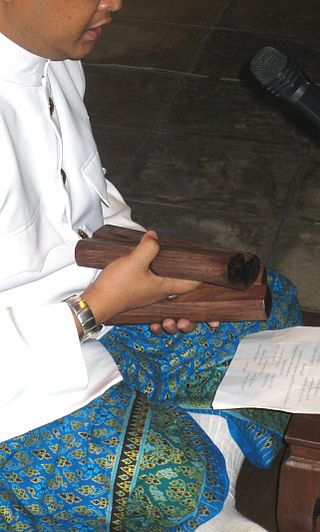
A percussion instrument is a musical instrument that is sounded by being struck or scraped by a beater including attached or enclosed beaters or rattles struck, scraped or rubbed by hand or struck against another similar instrument. Excluding zoomusicological instruments and the human voice, the percussion family is believed to include the oldest musical instruments. In spite of being a very common term to designate instruments, and to relate them to their players, the percussionists, percussion is not a systematic classificatory category of instruments, as described by the scientific field of organology. It is shown below that percussion instruments may belong to the organological classes of ideophone, membranophone, aerophone and cordophone.

In Spain, music has a long history. It has played an important role in the development of Western music, and has greatly influenced Latin American music. Spanish music is often associated with traditional styles such as flamenco and classical guitar. While these forms of music are common, there are many different traditional musical and dance styles across the regions. For example, music from the north-west regions is heavily reliant on bagpipes, the jota is widespread in the centre and north of the country, and flamenco originated in the south. Spanish music played a notable part in the early developments of western classical music, from the 15th through the early 17th century. The breadth of musical innovation can be seen in composers like Tomás Luis de Victoria, styles like the zarzuela of Spanish opera, the ballet of Manuel de Falla, and the classical guitar music of Francisco Tárrega. Nowadays commercial pop music dominates.

The most distinctive music of Uruguay is to be found in the tango and candombe; both genres have been recognized by UNESCO as an Intangible Cultural Heritage of Humanity. Uruguayan music includes a number of local musical forms such as murga, a form of musical theatre, and milonga, a folk guitar and song form deriving from Spanish and italian traditions and related to similar forms found in many American countries.
The music of the Canary Islands reflects its cultural heritage. The islands used to be inhabited by the Guanches which are related to Berbers; they mixed with Spaniards, who live on the islands now. A variant of Jota is popular, as is Latin music, which has left its mark in the form of the timple guitar. There has been a strong connection with Cuban music, Venezuelan, Puerto Rican, and other Caribbean countries both through commerce and migration.
Tim Hart was an English folk singer and multi-instrumentalist, best known as a founding member of British folk rock band Steeleye Span.

Pipe and tabor is a pair of instruments played by a single player, consisting of a three-hole pipe played with one hand, and a small drum played with the other. The tabor (drum) hangs on the performer's left arm or around the neck, leaving the hands free to beat the drum with a stick in the right hand and play the pipe with thumb and first two fingers of the left hand.

Gwo ka is a French creole term for big drum. Alongside Gwotanbou, simply Ka or Banboula (archaic), it refers to both a family of hand drums and the music played with them, which is a major part of Guadeloupean folk music. Moreover, the term is occasionally found in reference to the small, flat-bottomed tambourine played in kadri music, or even simply to drum (tanbou) in general.

The jota is a genre of music and the associated dance known throughout Spain, most likely originating in Aragon. It varies by region, having a characteristic form in Aragon, Catalonia, Castile, Navarre, Cantabria, Asturias, Galicia, La Rioja, Murcia and Eastern Andalusia. Being a visual representation, the jota is danced and sung accompanied by castanets, and the interpreters tend to wear regional costumes. In Valencia, the jota was once danced during interment ceremonies.

Castanets, also known as clackers or palillos, are a percussion instrument (idiophone), used in Spanish, Kalo, Moorish, Ottoman, Italian, Mexican, Sephardic, Swiss, and Portuguese music. In ancient Greece and ancient Rome there was a similar instrument called the crotalum. The instrument consists of a pair of concave shells joined on one edge by a string. They are held in the hand and used to produce clicks for rhythmic accents or a ripping or rattling sound consisting of a rapid series of clicks. They are traditionally made of hardwood, although fibreglass has become increasingly popular.

Water drums are a category of membranophone characterized by the filling of the drum chamber with some amount of water to create a unique resonant sound. Water drums are used all over the world, but are found most prominently in a ceremonial as well as social role in the Indigenous music of North America, as well as in African music. The drums are most often made from a pot of clay, ceramic, wood or metal, with a small amount of liquid inside and topped with drum head consisting of a stretched membrane, usually of some type of animal hide.

Spoons can be played as a makeshift percussion instrument, or more specifically, an idiophone related to the castanets. They are played by hitting one spoon against the other.

The string drum or Tambourin de Béarn is a long rectangular box zither beaten with a mallet. It is paired with a one-handed flute with three finger holes, similar to a pipe and tabor. It has also been called tambourin de Gascogne, tambourin à cordes in Catalan, Pyrenean string drum, ttun-ttun in Basque [cunˈcun], salmo in Spanish, and chicotén in Aragonese. It was known in the middle ages as the choron or chorus.

The three-hole pipe, also commonly known as tabor pipe or galoubet, is a wind instrument designed to be played by one hand, leaving the other hand free to play a tabor drum, bell, psalterium or tambourin à cordes, bones, triangle or other percussive instrument.

The xeremia is a type of bagpipe native to the island of Majorca (Mallorca). It consists of a bag made of skin, known as a sac or sarró which retains the air, a blowpipe (bufador), a melody pipe or chanter (grall), and several, generally three, drones (bordons). The primary drone (roncó) sounds a tonic note, but the other drones are sometimes simply false drones for ornamentation.

The bodhrán is a frame drum used in Irish music ranging from 25 to 65 cm (10–26 in) in diameter, with most drums measuring 35–45 cm (14–18 in). The sides of the drum are 9–20 cm deep. A goatskin head is tacked to one side. The other side is open-ended for one hand to be placed against the inside of the drum head to control the pitch and timbre.
Tajaraste is combined music and dance typical of the Canary Islands, (Spain). It is specific to the islands of Tenerife and La Gomera. Essentially an upbeat, happy and syncopated rhythm, danced in pairs accompanied by tambourines, drums and small castanet-like instruments called chácaras.

The krap is a Southeast Asian musical instrument used in Cambodia and Thai for percussion.
The Panamanian punto is a Hispanic musical genre which includes melodic and choreographic form. It has composition created specifically for dance, typically performed by a single couple as a demonstration of skill, precision and grace. Unlike the tamborito and the Panamanian cumbia, it is performed as an intermission between other dances or music at a party or event.

Cumbia[ˈkumbja] is a musical genre and folk dance from Panama.

















